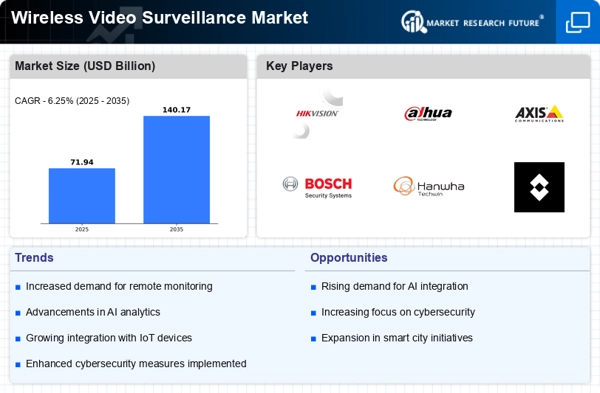Rising Security Concerns
In an era marked by increasing security threats, the Wireless Video Surveillance Market is witnessing heightened demand for surveillance solutions. Organizations and individuals alike are becoming more aware of the need to protect assets, personnel, and sensitive information. This growing concern is driving investments in advanced surveillance technologies, as businesses seek to mitigate risks associated with theft, vandalism, and other criminal activities. According to recent statistics, the global crime rate has seen fluctuations, but the need for effective surveillance remains constant. Consequently, the market is expected to expand significantly, with a projected increase in revenue driven by the adoption of wireless video surveillance systems across various sectors, including commercial, residential, and governmental.
Regulatory Compliance and Standards
The Wireless Video Surveillance Market is influenced by the increasing emphasis on regulatory compliance and standards related to security and privacy. Governments and regulatory bodies are establishing guidelines that mandate the use of surveillance systems in certain sectors, such as banking, healthcare, and transportation. Compliance with these regulations not only enhances security but also protects organizations from potential legal liabilities. As a result, businesses are investing in wireless video surveillance solutions to ensure adherence to these standards. The market is expected to benefit from this trend, as organizations recognize the importance of maintaining compliance while enhancing their security infrastructure.
Growth of E-commerce and Retail Security
The Wireless Video Surveillance Market is significantly impacted by the growth of e-commerce and the corresponding need for enhanced retail security. As online shopping continues to rise, brick-and-mortar stores are increasingly adopting surveillance systems to protect their physical assets and ensure customer safety. The retail sector is projected to invest heavily in wireless video surveillance solutions, with estimates suggesting a market growth of over 20% in this segment alone. This trend is driven by the need to deter theft, monitor customer behavior, and enhance overall security measures. Consequently, the wireless video surveillance market is poised for substantial growth as retailers recognize the value of advanced surveillance technologies.
Integration with Smart Home Technologies
The Wireless Video Surveillance Market is increasingly aligning with the rise of smart home technologies. As consumers seek to enhance their home security, the integration of wireless video surveillance systems with smart home devices is becoming more prevalent. This synergy allows users to monitor their properties remotely through smartphones and other connected devices, providing real-time alerts and video feeds. The market for smart home devices is projected to reach USD 174 billion by 2025, indicating a substantial opportunity for wireless video surveillance solutions to capitalize on this trend. As homeowners prioritize convenience and security, the demand for integrated surveillance systems is likely to grow, further propelling the wireless video surveillance market.
Technological Advancements in Surveillance Equipment
The Wireless Video Surveillance Market is experiencing a surge in technological advancements, particularly in camera resolution and connectivity options. Enhanced image quality, such as 4K and even 8K resolution, is becoming increasingly common, allowing for clearer and more detailed footage. Additionally, the integration of advanced connectivity options, including Wi-Fi 6 and 5G, facilitates faster data transmission and improved reliability. These advancements not only enhance the user experience but also expand the potential applications of wireless video surveillance systems across various sectors, including retail, transportation, and public safety. As a result, the market is projected to grow at a compound annual growth rate (CAGR) of approximately 15% over the next five years, indicating a robust demand for cutting-edge surveillance solutions.

















Leave a Comment